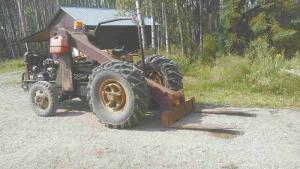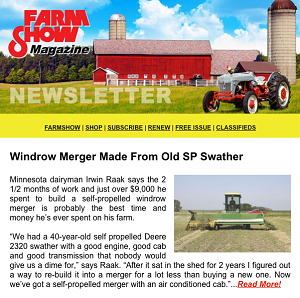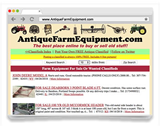“Thunder Buggy” Forklift Tractor
 ✖  |
Allan Isaac has been semi-retired for a while, but occasionally the Farmington, British Columbia, man still starts up the heavy-duty forklift tractor he built from scratch more than 30 years ago.
“My family calls it the Thunder Buggy. It doesn’t have a muffler, so it makes a lot of noise,” says Isaac. “It’s low to the ground, so it’s very stable. I don’t have to worry about tipping over,” says Isaac. “Also, with the big tires on the front I don’t have to worry about getting stuck.
“I built it after my brother and I quit farming and logging, and I started a welding shop,” says Isaac. “We built a lot of portable bandsaw mills in the shop and often carried supplies or equipment in and out of it. I decided I needed a heavy-duty forklift to make the work easier.”
The forklift is powered by a Slant-6 engine coupled to an automatic transmission off a Dodge car. It rides on big 18.4 by 30 combine tires on the front and 7.50 by 18s on the back. The front axle is off a 1964 IH tandem axle truck and the rear axle off a 1958 Ford 2-ton truck. The tractor’s frame is also off the truck. The controls and steering wheel are off an Oliver 1850 tractor.
The mast on the front is supported by a single loader arm that extends diagonally all the way to the back of the tractor. It’s made from 6 by 10 by 1/2-in. thick steel tubing and can lift loads up to 10 ft. high and handle up to 5,000 lbs.
The forks measure 9 in. wide and are made from 1 1/4-in. thick T1 steel, and are tilted up or down by a 5-in. dia. hydraulic cylinder. One fork is welded to a 5-in. O.D. by 3-in. I.D. heavy wall pipe with a 3-in. dia. pin going through it to serve as a hinge. The other fork is welded to a movable bracket that hooks over the top of the pipe, allowing Isaac to adjust fork spacing from 2 1/2 to 4 ft. apart.
“I’ve used this loader tractor to haul engines, load and unload trucks, and do many other jobs. There’s nothing it hasn’t done,” says Isaac. “The big tires on the front provide good traction. The tractor’s automatic transmission drives through another 4-speed transmission to slow the wheels down. If I want, I can remove one fork and use the other to dig trees out of the ground. I can also replace the forklift with a bucket to scoop dirt.
“It cost very little to build. My only expense was $250 for a single big hydraulic cylinder used to tilt the forks.”
The forklift is powered by a 2-stage hydraulic pump driven directly off the engine crankshaft. “One stage of the pump does the lifting, and the other stage operates the power steering,” says Isaac.
He used 2-in. tubing to make a rollbar that extends over the operator. A big yellow flashing beacon is mounted on top of the tractor. “My sons added the beacon years ago as a safety precaution, but I work by myself now, so I don’t use it anymore,” notes Isaac.
Contact: FARM SHOW Followup, Allan Isaac, 4031 Old Alaska Hwy., Peace River Regional District, Dawson Creek, B.C., Canada V1G 0J4 (ph 250-794-1416; adisaac@telus.net).
“Thunder Buggy” Forklift Tractor MISCELLANEOUS EQUIPMENT Forklifts Allan Isaac has been semi retired for a while but occasionally the Farmington British Columbia man still starts up the heavy-duty forklift tractor he built from scratch more than 30 years ago “My family calls it the Thunder Buggy It doesn’t have a muffler so it makes a lot of noise ” says Isaac “It’s low to the ground so it’s very stable I don’t have to worry about tipping over ” says Isaac “Also with the big tires on front I don’t have to worry about getting stuck “I built it after my brother and I quit farming and logging and I started a welding shop ” says Isaac “We built a lot of portable bandsaw mills in the shop and often carried supplies or equipment in and out of it I decided I needed a heavy-duty forklift to make the work easier ” The forklift is powered by a slant 6 engine coupled to an automatic transmission off a Dodge car It rides on big 18 4 by 30 combine tires on front and 7 50 by 18’s on back The front axle is off a 1964 IH tandem axle truck and the rear axle off a 1958 Ford 2-ton truck The tractor’s frame is also off the truck The controls and steering wheel are off an Oliver 1850 tractor The mast on front is supported by a single loader arm that extends diagonally all the way to the back of the tractor It’s made from 6 by 10 by 1/2-in thick steel tubing and can lift loads up to 10 ft high and handle up to 5 000 lbs The forks measure 9 in wide and are made from 1 1/4-in thick T1 steel and are tilted up or down by a 5-in dia hydraulic cylinder One fork is welded to a 5-in O D by 3-in I D heavy wall pipe with a 3-in dia pin going through it to serve as a hinge The other fork is welded to a movable bracket that hooks over the top of the pipe allowing Isaac to adjust fork spacing from 2 1/2 to 4 ft apart “I’ve used this loader tractor to haul engines load and unload trucks and do many other jobs There’s nothing it hasn’t done ” says Isaac “The big tires on front provide good traction The tractor’s automatic transmission drives through another 4-speed transmission to slow the wheels down If I want I can remove one fork and use the other to dig trees out of the ground I can also replace the forklift with a bucket to scoop dirt “It cost very little to build My only expense was $250 for a single big hydraulic cylinder that’s used to tilt the forks ” The forklift is powered by a 2-stage hydraulic pump that’s driven directly off the engine crankshaft “One stage of the pump does the lifting and the other stage operates the power steering ” says Isaac He used 2-in tubing to make a rollbar that extends over the operator A big yellow flashing beacon is mounted on top of the tractor “My sons added the beacon years ago as a safety precaution but I work by myself now so I don’t use it any more ” notes Isaac Contact: FARM SHOW Followup Allan Isaac 4031 Old Alaska Hwy Peace River Regional District Dawson Creek B C Canada V1G 0J4 ph 250 794-1416; adisaac@telus net
To read the rest of this story, download this issue below or click
here to register with your account number.





